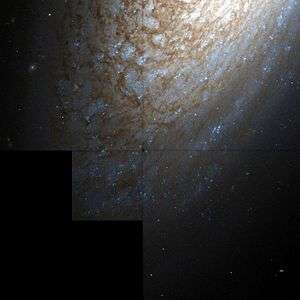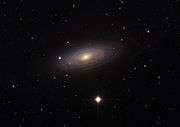NGC 2841
NGC 2841 is an inclined, unbarred, spiral galaxy in the constellation Ursa Major that exhibits a prominent inner ring structure. It was discovered on 9 March 1788 by William Herschel.[2] Initially thought to be about 30 million light-years distant, a 2001 Hubble Space Telescope survey of the galaxy's Cepheid variables determined its distance to be approximately 14.1 megaparsecs or 46 million light-years.[3]
| NGC 2841 | |
|---|---|
 Image taken by the Hubble Space Telescope. | |
| Observation data (J2000 epoch) | |
| Constellation | Ursa Major |
| Right ascension | 9h 22m 02.6s[1] |
| Declination | +50° 58′ 35″[1] |
| Redshift | 638 ± 3 km/s[1] |
| Apparent magnitude (V) | 10.1[1] |
| Characteristics | |
| Type | SA(r)b, LINER[1] |
| Apparent size (V) | 8′.1 × 3′.5[1] |
| Other designations | |
| UGC 4966, PGC 26512[1] | |
Structure
NGC 2841 is a giant spiral galaxy with properties similar to those of the Andromeda Galaxy.[3] It is a prototypical flocculent spiral galaxy, a type of spiral galaxy whose arms are patchy and discontinuous.[4]
NGC 2841 is home to a large population of young blue stars, and a few H II regions.[5]
LINER emission
NGC 2841 contains a low-ionization nuclear emission-line region (LINER), a type of region that is characterized by spectral line emission from weakly ionized atoms.[6]
Gallery
 Hubble image of NGC 2841.
Hubble image of NGC 2841. Picture taken at the Mount Lemmon SkyCenter showing the whole galaxy.
Picture taken at the Mount Lemmon SkyCenter showing the whole galaxy.
References
- "NASA/IPAC Extragalactic Database". Results for NGC 2841. Retrieved 2006-10-04.
- "Celestial Atlas". Cseligman. Retrieved 2016-03-01.
- Macri, L. M.; Stetson, P. B.; Bothun, G. D.; Freedman, W. L.; et al. (September 2001). "The Discovery of Cepheids and a New Distance to NGC 2841 Using the Hubble Space Telescope". Astrophysical Journal. 559 (1): 243–259. arXiv:astro-ph/0105491. Bibcode:2001ApJ...559..243M. doi:10.1086/322395. ISSN 0004-637X.
- "A Near-Infrared Atlas of Spiral Galaxies", by Debra Meloy Elmegreen, "CH3. Discussion" (accessed 23 April 2010)
- Marochnik, Leonid; Suchkov, Anatoly (1995-11-01). Milky Way Galaxy (1st ed.). Routledge. p. 267. ISBN 978-2-88124-931-0.
- L. C. Ho; A. V. Filippenko; W. L. W. Sargent (1997). "A Search for "Dwarf" Seyfert Nuclei. III. Spectroscopic Parameters and Properties of the Host Galaxies". Astrophysical Journal Supplement. 112 (2): 315–390. arXiv:astro-ph/9704107. Bibcode:1997ApJS..112..315H. doi:10.1086/313041.
External links
| Wikimedia Commons has media related to NGC 2841. |
- NGC 2841 on WikiSky: DSS2, SDSS, GALEX, IRAS, Hydrogen α, X-Ray, Astrophoto, Sky Map, Articles and images